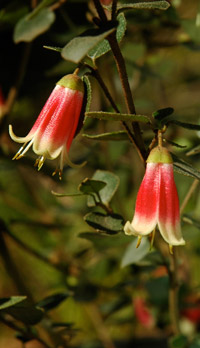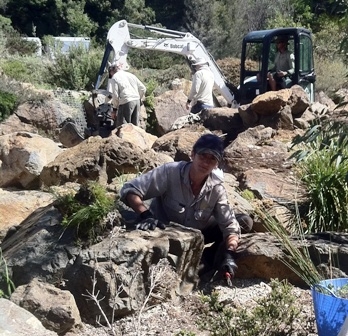News at the Australian National Botanic Gardens
July 2011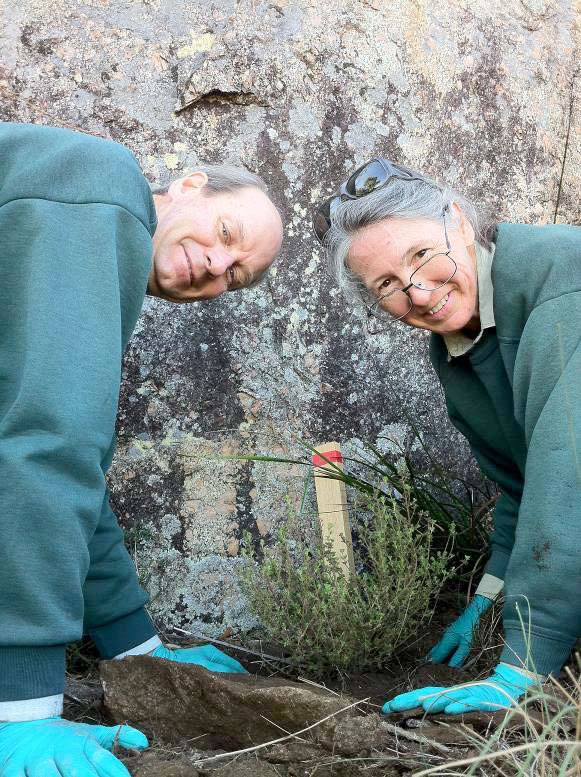
Helping save a nationally endangered plant
A team from the Australian National Botanic Gardens has propagated, nursed and now transplanted into the wild a nationally endangered plant. The endangered aromatic shrub Zieria obcordata is found on only seven sites in New South Wales, all on private land. When one landowner saw his populations plummeting in the drought, he called for help.
Zieria is notoriously difficult to cultivate — but Gardens’ horticulturist Paul Carmen and his threatened species team experimented with various techniques and found that extending the hardening off period before potting meant the plants survive post plant-out shock. Now 46 plants have been restored to the wild. The Gardens began propagating the Zieria from cuttings in 2008 and has some plantings along the Main Path.
Image: Horticulturalist Paul Carmen and Conservation Volunteer Cathy Hook planting out a Zieria obcordata.
May 2011
What's it like out there?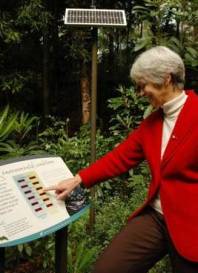
Answer that question and get new insights into the microclimates Australian plants need to survive by checking the new environmental monitoring stations at the Gardens.
Two monitoring stations have been installed in the Rainforest Gully and a eucalypt woodland along the main path allowing you to compare the very different weather and soil conditions of each ecosystem. Each station measures temperature, humidity, wind speed, light levels, soil temperature and soil moisture and displays the results from each site.
Also, a new interactive kiosk at the Visitors Centre allows you to explore data from the two sites for the day, week, month, or even the year.
Both the new computer displays and the hands on interactive displays will give schoolchildren and other visitors a better understanding of the extremes of the Australian environment.
Temperatures and humidity remain relatively constant within the rainforest, but can fluctuate quite dramatically in an open woodland — where the ground might be covered in frost during an early morning winter and then baked by a scorching sun in the middle of a summer’s day.
Woodland plants have evolved to cope with these harsher conditions, whereas the unique microclimates of rainforests helps fragile plants survive.
The environmental monitoring stations were generously funded by the Public Fund of the Friends of the Gardens.
Image: Dr Judy West, Gardens' Executive Director, compares conditions in the Rainforest Gully with those in a eucalypt woodland.
April 2011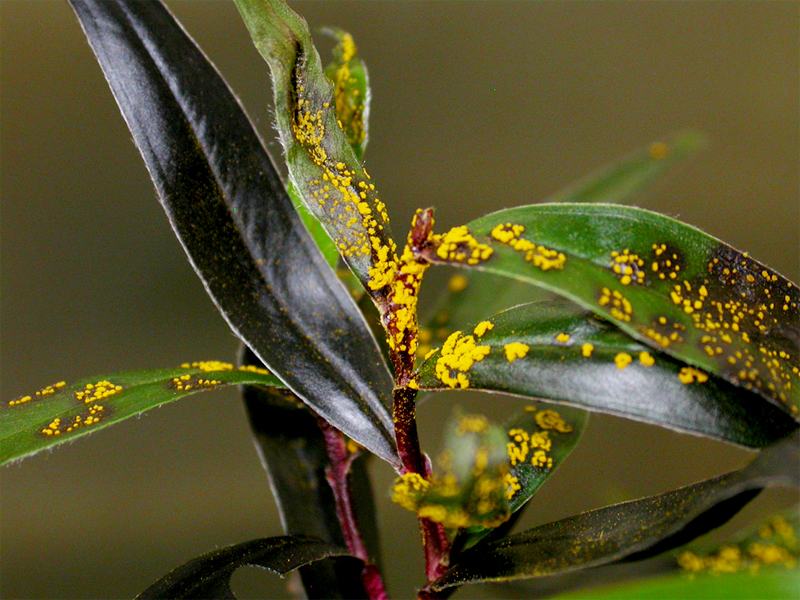
Look out for myrtle rust
‘Please don’t take plants you suspect to be infected with myrtle rust into botanic gardens or nurseries!’
That was they key message from a workshop with Australia's leading plant and fungal scientists, industry and government agencies last month at the Australian National Botanic Gardens.
The group met to explore options for managing the outbreak of the South American fungal disease, myrtle rust, which affects some of Australia’s most iconic plants, including eucalypts, bottle brush, tea tree and other members of the Myrtaceae family.
All agreed that we need to learn to live with the invasive fungus - which means containing and controlling it.
Gardens Executive director Dr Judy West said the workshop brought horticulture and agriculture experts together with Australia’s botanic gardens to update what we know about the disease in the Australian environment. “We especially looked at what we still need to learn so that we can determine research priorities and common protocols for reporting myrtle rust,” Dr West said.
The Australian National Botanic Gardens is developing a management strategy to protect our investment in the 65,000 plants that we have growing. This is the only place in the world where you can see this diversity of Australian native plants in one location and it’s a great scientific research centre – so it is critical that we protect this collection.
Since the fungus first emerged in a central New South Wales plant nursery last April, it has spread to the north and south of the state and up to Queensland.
A fact sheet about myrtle rust can be found on the Department of the Environment's invasive species pages.
For a comprehensive look at the perils of myrtle rust, tune into ABC Bush Telegraph’s podcast.
Please keep an eye out for myrtle rust in your area. Powdery, bright yellow pustules on plants in your garden or the bush may indicate infection. If you think a plant has it – take a photo and email it to anbg-info@anbg.gov.au.
March 2011
Turning on the taps to a new era in water savings
This month marks a new era in water savings at the Gardens.
Parliamentary Secretary for Sustainability and Urban Water, Senator Don Farrell, and ACT Senator Kate Lundy did the honours of turning on the taps to a new non-potable water system which will irrigate the Garden’s collection of 65,000 Australian plants.
The new irrigation system, which draws its supply from Lake Burley Griffin, will save 170 million litres of water each year from Canberra’s reservoirs and guarantee water for the garden’s collection of native plants.
The project complements other water efficiency measures in place in the Gardens like the computerised irrigation system.
Scaling to new heights with Alpine research display in the Rock Garden
Staff have been out in full force breaking ground for a new alpine display to feature plants from the Australian alps.
The display will showcase a selection of plants collected as seed through the Gardens’ joint alpine research project. Staff will be able to use the display to experiment with growing alpine plants outside of the nursery. Planting of the garden bed is due to begin in April.
The Alps are one of the most plant-rich areas in our country and their fragile ecology among the most vulnerable to a changing climate. Little is currently known about how to actually grow most alpine plants from seeds. The value of our seed collections for long-term conservation and rehabilitation of different alpine species depends on this knowledge.
The alpine display is part of a larger research project tackling the impact of climate change in the Australian Alps. The project involves collection and storage of alpine seeds, as well as plant germination trials and ecological field studies on previously unstudied species.
Partners in the research project include the Gardens, the Australian National University, University of Queensland and the Friends of the Gardens. Gardens' staff are hopeful for access to future funding to be able to develop the display into an Australian alpine garden.
Aquatic collecting in Canberra

Canberra is not the place you would expect to collect plant specimens by boat, but that was the only solution when it came to invasive waterlilies in Lake Burley Griffin.
Our herbarium staff had noticed the waterlily leaves while surveying the ACT plants several years ago, but this was the first year they had been observed in flower - by binoculars from the bank.
To collect the plant, field botanist Dave Mallinson used his own kayak, launched amid the willows and blackberries of the Jerrabombera Wetlands of Lake Burley Griffin. The tentative identification is Nymphaea mexicana, and from aerial photographs it appears to be spreading. The information will be passed on to the ACT government for action.
January 2011
Gardens join effort to save a species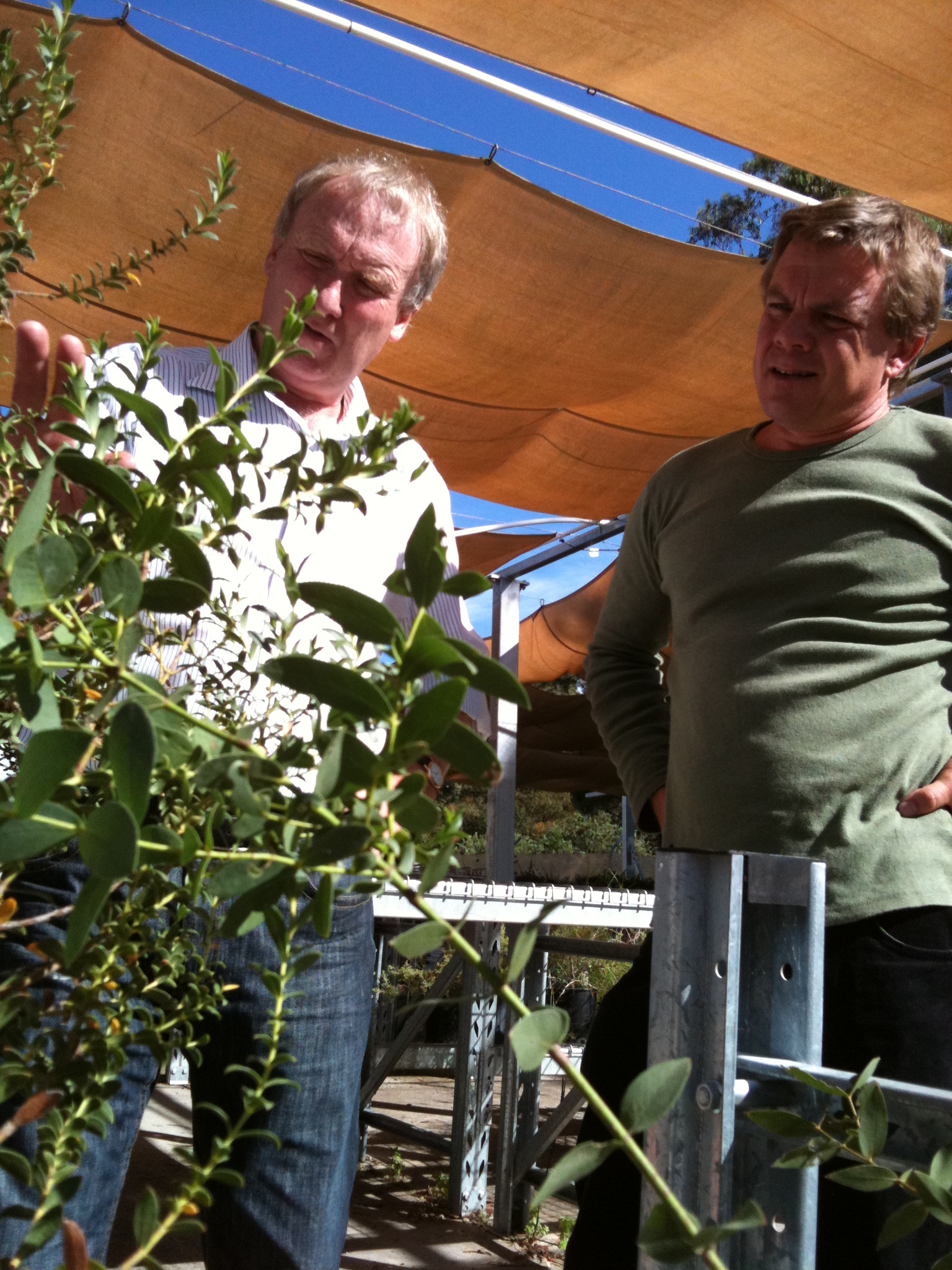
One of the country's rarest eucalypts is now being conserved at the Gardens. Only 5 individuals of Eucalyptus recurva, commonly known as the Mongarlowe Mallee, are known to exist in the wild.
The New South Wales Department of Environment and Climate Change donated a graft of the plant to the Gardens this month.
Previous efforts to reproduce the species from tissue culture and cuttings had failed, but one grafting trial was successful. The surviving graft is from a plant at Mongarlowe onto the stock of Eucalyptus parvula, or small-leaved gum.
Gardens’ staff are hopeful they can conserve and propagate the plant to help ensure its survival.
2010 news
![Director of National Parks [logo]](../../../images/dnp_90px.gif)





